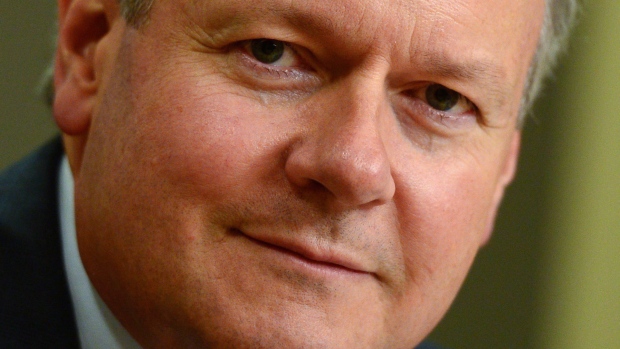Jun 28, 2017
Markets ‘bashed over the head’ as Bank of Canada hints at rate hike
By Greg Bonnell

Debt-laden Canadians can’t say they haven’t been warned.
Bank of Canada officials have been beating the hawkish drum in recent weeks, but not everyone was fully convinced about a rate hike until Governor Stephen Poloz doubled down Wednesday on the tough talk.
Surely oil in the mid-40s and tepid inflation would cause Poloz to rethink a hike as early as July 12? Well, apparently not.
“We’re just approaching a new interest rate decision,” Poloz said in a CNBC interview in Portugal, where he’s participating in an ECB-led panel.
“I don’t want to prejudge that, but certainly we need to be at least considering that whole situation now that capacity – excess capacity – is being used up steadily.”
- Loonie notches biggest gain since March as BoC rate hike bets jump
- Poloz reiterates low rates have 'done their job'
- Drag from cheap oil largely over, Bank of Canada says
RELATED CONTENT
That’s a central banker’s way of saying the economy is back on its feet and getting closer to its full potential.
That comes after the Bank cut rates twice in 2015 in the face of plunging crude prices.
With the Bank’s next rate decision just two weeks way, BMO Capital Markets says “it’s time to take that stimulus back.”
HAVE YOUR SAY
Do you think the Bank of Canada should raise rates next month?
“Following two weeks of being bashed over the head by Bank of Canada officials warning that rate hikes are on the table, BMO is now calling for a Bank of Canada rate hike at the July 12 policy meeting,” Benjamin Reitzes, Canadian rates and macro strategist, said in a note to clients.
With the market pricing in a near 70 per cent chance of a hike at the July meeting, the Canadian dollar is trading at its highest levels since February. It’s a sharp rebound from the sell-Canada trade bought on by bearish investors betting against our banks and currency as oil slid and the Home Capital crisis unfolded. That pushed the loonie below 73 cents in early May.
Poloz’s comments in Portugal, BMO said, “were the final straw prompting the shift” in their rate call. “That’s a pretty strong and clear-cut signal that a July rate hike is very much on the table,” Reitzes added.
It was Poloz’s senior deputy, Carolyn Wilkins, that got the rate-hike ball rolling two weeks ago. During a speech in Winnipeg, Wilkins said as economic “growth continues and, ideally, broadens further, (the bank’s) governing council will be assessing whether all the considerable monetary policy stimulus presently in place is still required.”
It was a striking change of tone, in central bank terms.
And on Wednesday, deputy governor Lynn Patterson told financial analysts in Calgary the worst of the crash in crude was behind us. Patterson also indicated that the bank’s Business Outlook Survey, to be released this Friday, was giving them invaluable intelligence on the economy.
The bank’s strong words has Manulife Senior Economist Frances Donald pulling her rate-hike prediction forward as well, but to this October.
“July is certainly a live meeting,” Donald said in an internal note.
“But we are, as of today, cautious of shifting that hawkish ourselves in advance of Friday’s April GDP report and next week’s May export figures and June jobs numbers.”
The July to September timeframe, Donald adds, is full of uncertainties – including the fate of Greater Toronto’s housing market and NAFTA negotiations.
While a 25-basis-point boost may seem insignificant, CIBC recently warned that record household debt loads will make each interest rate increase “all the more potent.”
The Parliamentary Budget Office expressed its concern last week, noting rising rates will strain household finances. In a low rate environment, servicing that debt hasn’t been a big issue. But as rates rise, a greater share of disposable income will be needed to keep up with interest payments.
If you have a fixed-rate mortgage, you’re insulated at least for the remaining term of the loan. Come renewal time, you could be facing higher borrowing costs.
Floating rate mortgages and home equity lines of credit with interest rates that move with bank prime rates will feel the upward pressure.
If you’re hopeful for a call that keeps interest lower for longer, look no further than Capital Economics. The longstanding bears on Canadian housing expect the Bank of Canada’s next move to be a rate cut in early 2018. That’s predicated on an economic downturn sparked by a correction in home prices, among other factors.